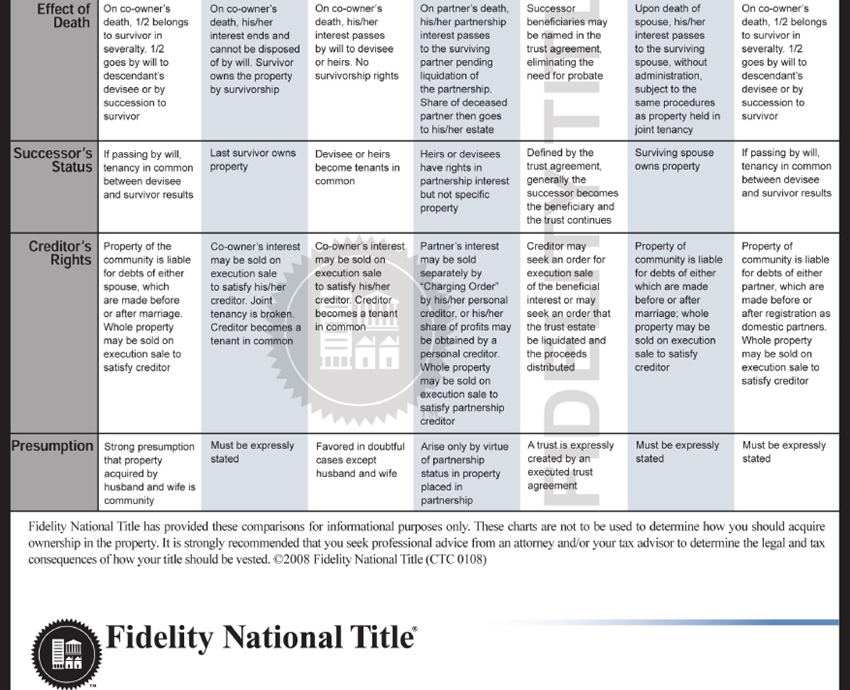Ways to Hold Title to Property
Fidelity National Title has put together a good overview of common ways to hold property title in the state of California and the meaning and ramifications of each way. This is simply an overview provided as an introduction to this important issue: you should discuss your specific circumstances and plans with your accountant and attorney before coming to a conclusion.
If you find the below table difficult to read, try this link where you can also download the PDF: Guide to Common Ways to Hold Title in California


The below is excerpted from the General Information for Buyers and Sellers guide published by the San Francisco Association of Realtors (Revise date 11/12)
Taking Title - How a buyer takes title can have an impact on financing, estate planning and other important issues.
Title to real property may be taken as a sole or concurrent owner. Concurrent ownership involves ownership by two or more persons and includes tenancy-in-common, joint tenancy and community property.
As a sole owner, one person alone enjoys the benefits of real property and is subject to the accompanying burdens, such as the payment of taxes. A sole owner is free to dispose of real property at will, and normally only a sole owner’s signature is required on the deed of conveyance. In fact, even after marriage, a husband or wife may continue to own real (and personal) property separately from the other spouse under certain circumstances.
A tenancy-in-common exists where two or more persons are owners of an undivided interest in real property. Generally, each owner (or tenant-in-common) has a right to possession of the entire property and no owner may exclude any other owner from any portion of the property or claim any portion for himself or herself alone, unless otherwise provided in a written agreement. Additionally, unless a written agreement provides otherwise, any tenant-in-common is free to sell, convey or mortgage the tenant’s interest in the property as he or she sees fit, and the new owner simply takes his or her place as a tenant-in-common with the other owner or owners.
Joint tenancy exists where two or more persons are joint and equal owners of the same undivided interest in real property (in other words, each joint tenant equally owns the real property as a whole, as opposed to owning a percentage interest only). The most important characteristic of joint tenancy is the right of survivorship. It means that if one joint tenant dies, the surviving joint tenant immediately becomes the sole owner.
Community property basically consists of all property, other than separate property, acquired by a husband and wife or either of them during a valid marriage.
The manner in which title to real property is held can significantly affect the rights and liabilities of the owner(s). And those rights and liabilities are subject to being changed by state and local government. For example, in San Francisco, the Board of Supervisors has attempted to restrict the rights of tenants-in-common in the past and may do so in the future. For these and other reasons, buyers are urged to consult with a qualified real estate attorney knowledgeable regarding San Francisco real property issues to determine what form of ownership best fits their needs.
Laws regulating title are subject to change.
